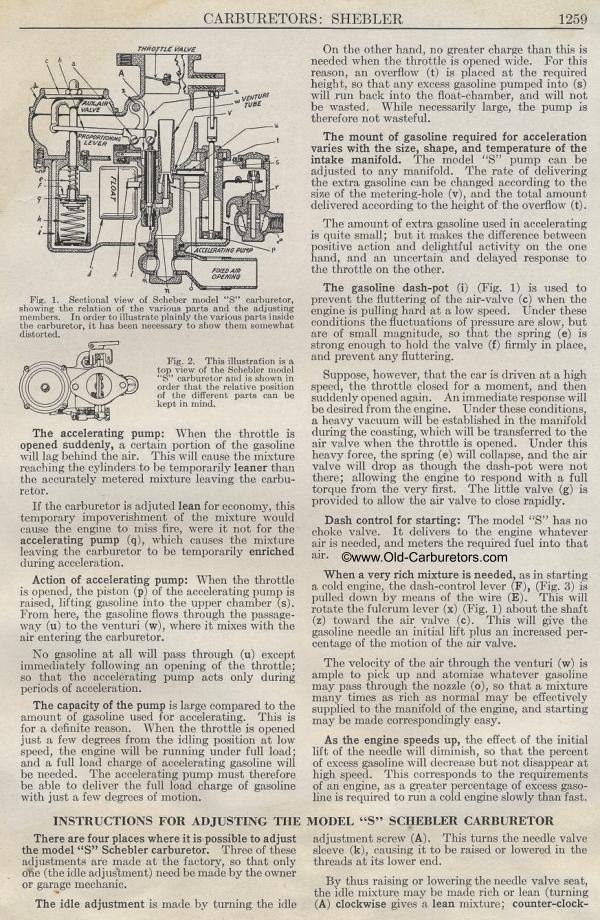CARBURETORS : SHEBlER
Fig. 1. Sectional view of Schebler model "S" carburetor,
showing the relation of the various parts and the adjusting members.
In order to illustrate plainly the various parts inside the carburetor,
it has been necessary to show them somewhat distorted.
Fig. 2. This illustration is a top view of the Schebler model "S" carburetor
and is shown in order that the relative position of the different
parts can be kept in mind.
The accelerating pump: When the throttle is opened suddenly, a
certain portion of the gasoline will lag behind the air. This will
cause the mixture reaching the cylinders to be temporarily leaner
than the accurately metered mixture leaving the carburetor.
If the carburetor is adjuted lean for economy, this temporary impoverishment
of the mixture would cause the engine to miss fire, were it not
for the accelerating pump (q), which causes the mixture leaving
the carburetor to be temporarily enriched during acceleration.
Action of accelerating pump: When the throttle is opened, the piston
(p) of the accelerating pump is raised, lifting gasoline into the
upper chamber (s). From here, the gasoline flows through the passage-way
(u) to the venturi (w), where it mixes with the air entering the
carburetor.
No gasoline at all will pass through (u) except immediately following
an opening of the throttle; so that the accelerating pump acts
only during periods of acceleration.
The capacity of the pump is large compared to the amount of gasoline
used for accelerating. This is for a definite reason. When the
throttle is opened just a few degrees from the idling position
at low speed, the engine will be running under full load; and a
full load charge of accelerating gasoline will be needed. The accelerating
pump must therefore be able to deliver the full load charge of
gasoline with just a few degrees of motion.
On the other hand, no greater charge than this is needed when the
throttle is opened wide. For this reason, an overflow (t) is placed
at the required height, so that any excess gasoline pumped into
(s) will run back into the float-chamber, and will not be wasted.
While necessarily large, the pump is therefore not wasteful.
The mount of gasoline required for acceleration varies with the
size, shape, and temperature of the intake manifold. The model "S" pump
can be adjusted to any manifold. The rate of delivering the extra
gasoline can be changed according to the size of the metering-hole
(v), and the total amount delivered according to the height of
the overflow (t).
The amount of extra gasoline used in accelerating is quite small;
but it makes the difference between positive action and delightful
activity on the one hand, and an uncertain and delayed response
to the throttle on the other.
The gasoline dash-pot (i) (Fig. 1) is used to prevent the fluttering
of the air-valve (c) when the engine is pulling hard at a low speed.
Under these conditions the fluctuations of pressure are slow, but
are of small magnitude, so that the spring (e) is strong enough
to hold the valve (f) firmly in place, and prevent any fluttering.
Suppose, however, that. the car is driven at a high speed, the
throttle closed for a moment, and then suddenly opened again. An
immediate response will be desired from the engine. Under these
conditions, a heavy vacuum will be established in the manifold
during the coasting, which will be transferred to the air valve
when the throttle is opened. Under this heavy force, the spring
(e) will collapse, and the air valve will drop as though the dash-pot
were not there; allowing the engine to respond with a full torque
from the very first. The little valve (g) is provided to allow
the air valve to close rapidly.
Dash control for starting: The model "S" has no choke
valve. It delivers to the engine whatever air is needed, and meters
the required fuel into that air.
When a very rich mixture is needed, as in starting a cold engine,
the dash-control lever (F), (Fig. 3) is pulled down by means of
the wire (E). This will rotate the fulcrum lever (x) (Fig. 1) about
the shaft (z) toward the air valve (c). This will give the gasoline
needle an initial lift plus an increased percentage of the motion
of the air valve.
The velocity of the air through the venturi (w) is ample to pick
up and atomize whatever gasoline may pass through the nozzle (o),
so that a mixture many times as rich as normal may be effectively
supplied to the manifold of the engine, and starting may be made
correspondingly easy.
As the engine speeds up, the effect of the initial lift of the
needle will diminish, so that the percent of excess gasoline will
decrease but not disappear at high speed. This corresponds to the
requirements of an engine, as a greater percentage of excess gasoline
is required to run a cold engine slowly than fast.
INSTRUCTIONS FOR ADJUSTING THE MODEL "S" SCHEBLER
CARBURETOR
There are four places where it is possible to adjust the model "S" Schebler
carburetor. Three of these adjustments are made at the factory,
so that only one (the idle adjustment) need be made by the owner
or garage mechanic.
The idle adjustment is made by turning the idleadjustment screw
(A). This turns the needle valve sleeve (k), causing it to be raised
or lowered in the threads at its lower end.
By thus raising or lowering the needle valve seat, the idle mixture
may be made rich or lean (turning (A) clockwise gives a lean mixture;
counter clock wise
Previous page 1927
Supplement Home Next page 
|
